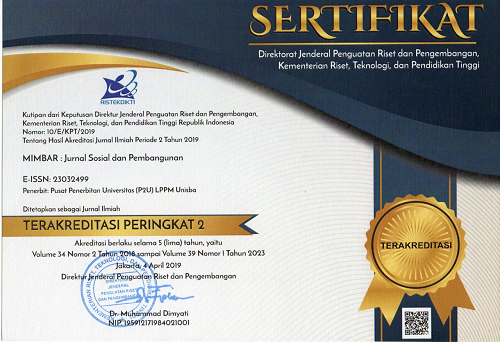Model of Communication Program Corporate Social Responsibility for Empowerment Community
Abstract
Keywords
Full Text:
PDFReferences
Indocement. 2015 Report Data Beneficiaries CSR Program 2015. Bogor (ID): PT Indocement Tunggal Perkasa, Tbk.
Ife J. 2006. Community Development: Creating Community Alternatives-Vision, Analysis and Practice. Australia (AU): Long Man.
Muhadjir, Qurani, Gita F. 2011. Pengaruh penerapan corporate social respobsibility terhadap persepsi nasabah bank dan dampaknya terhadap corporate image. Journal the Winner. Vol 12 No.2:180-195.
Mulyandari, RSH, Sumardjo, Lubis DP, Panjaitan, NK. 2010. Implementasi Cyber Extension Dalam Komunikasi Inovasi Pertanian. Jurnal Informatika Pertanian, Vol. 19 No 2.
Nair KS, White SA. 2004. Participatory Communication Working for Change and Development. White SA, Nair KS, Ascroft J, editor. New Delhi (IN): Sage Publications.
Payne M. 1997. Modern Social Work Theory. Second Ed. London (GB): MacMillan Press Ltd.
[Sekneg RI] Sekretariat Negara Republik Indonesia. 2012. Peraturan Pemerintah Republik Indonesia tentang Tanggung Jawab Sosial dan Lingkungan Perseroan Terbatas. Jakarta (ID): Sekneg RI.
Sari, RA. 2012. Pengaruh Karakteristik Perusahaan terhadap corporate social responsibility disclosure pada perusahaan manufaktur yang terdaftar di Bursa Efek Indonesia. Jurnal Nominal. Vol 1 No.1: 124 – 140
Semson. 2014. Studi tentang pelaksanaan program corporate social responsibility (CSR) PT Intracawood Manufacturing di Desa Seputuk Kecamatan Muruk Rian Kabupaten Tanang Tidung. eJournal Pemerintahan Intregatif, Vol.2 No.2: 139-153.
Suharto E. 2006. Membangun Masyarakat Memberdayakan Rakyat. Kajian Strategis Pembangunan Kesejahteraan Sosial dan Pekerjaan Sosial. Jakarta (ID): Refika Aditama.
Sulistiyani AT. 2004. Kemitraan dan Model-Model pemberdayaan. Yogyakarta (ID): Gaya Media.
Tufte T, Mefalopulos P. 2009. Participatory Communication: A Practikal Guide. Washington (US): The World Bank.
Warnock K, Schoemaker E, Wilson M. 2007. The Case for Communication in Sustainable Development. London (UK): Panos London.
Wibisono Y. 2007. Membedah Konsep dan Aplikasi CSR (Corporate Social Responsibility). Gresik (ID): Fascho Publishing.
Yulianita N. 2008. Corporate social responsibility (CSR) sebagai aktivitas sosial marketing public relations. Mediator. Vol. 9 No.1: 123-133
DOI: https://doi.org/10.29313/mimbar.v32i2.1845
Refbacks
- There are currently no refbacks.
MIMBAR : Jurnal Sosial dan Pembangunan is licensed under Creative Commons Attribution-NonCommercial-ShareAlike 4.0 International License.















